#memoir review
Text
I’m Glad My Mom Died- Jeanette McCurdy Review

Image taken from Entertainment Weekly.
Rating: 5 / 5
⭐️⭐️⭐️⭐️⭐️
A heartbreaking and hilarious memoir by iCarly and Sam & Cat star Jennette McCurdy about her struggles as a former child actor-including eating disorders, addiction, and a complicated relationship with her overbearing mother-and how she retook control of her life.
Jennette McCurdy was six years old when she had her first acting audition. Her mother's dream was for her only daughter to become a star, and Jennette would do anything to make her mother happy. So she went along with what Mom called "calorie restriction," eating little and weighing herself five times a day. She endured extensive at-home makeovers while Mom chided, "Your eyelashes are invisible, okay? You think Dakota Fanning doesn't tint hers?" She was even showered by Mom until age sixteen while sharing her diaries, email, and all her income.
In I'm Glad My Mom Died, Jennette recounts all this in unflinching detail-just as she chronicles what happens when the dream finally comes true. Cast in a new Nickelodeon series called iCarly, she is thrust into fame. Though Mom is ecstatic, emailing fan club moderators and getting on a first-name basis with the paparazzi ("Hi Gale!"), Jennette is riddled with anxiety, shame, and self-loathing, which manifest into eating disorders, addiction, and a series of unhealthy relationships. These issues only get worse when, soon after taking the lead in the iCarly spinoff Sam & Cat alongside Ariana Grande, her mother dies of cancer. Finally, after discovering therapy and quitting acting, Jennette embarks on recovery and decides for the first time in her life what she wants.
Told with refreshing candour and dark humour, I'm Glad My Mom Died is an inspiring story of resilience, independence, and the joy of shampooing your own hair.
McCurdy is probably best known for her role as Sam in the sitcom iCarly. After quitting acting, she turned to writing and created this amazing memoir that paints the real picture of her life as a child celebrity. In the beginning pages, an all-grown-up Jeanette McCurdy is watching her mother in a coma, while witnessing her three brothers whisper to her parent in hopes of waking her. When it’s the author's turn to address her mother, she tells her that her weight is 98 pounds- the goal her mother wanted McCurdy to reach.
This is the first sign of the emotional, physical, and mental abuse McCurdy suffered at the hands of her mother. This tells the reader what book they have signed up to read: a heartbreaking memoir about a woman trying to find a balance between violence and love.
Recently, abused celebrities, such as Paris Hilton, have taken the stand against the physical and mental abuse they endured growing up. This display of honesty shows their vulnerable side and ensures the reader's belief in their statements.
McCurdy is not stating I WAS ABUSED, she is attempting to navigate the difficulties she went through as a child and if she owes her mother anything. She includes her child-self’s P.O.V. and recounts her thoughts ‘I’m glad mom gets what she wants’, as it was earlier than dealing with the tantrums her mother threw regularly. Another heart-wrenching anecdote is when McCurdy realises she has hit puberty and her breasts are coming in, something which should be avoided to stop weight gain. She asked her mum to ‘stop the boobies coming’, and she helped her with the secrets of losing weight- calorie restriction which turned into a multitude of eating disorders as McCurdy got older. The author has a special talent for putting the reader in the child’s shoes, making them feel and see the whole innocence behind asking for a mother's help.
The author has taken time to remember the arduous stages of her life and translated that into an understandable text for the reader. This memoir is an absolute triumph and credit to McCurdy and an excellent read that I highly recommend.
#book review#book#bookaddict#bookworm#jenette mccurdy#im glad my mom died#book cover#bibliophile#books and reading#icarly revival#miranda cosgrove#memoir#memoir review#nonfiction#tv series#book recommendations#review#new release#readers#movie reviewer#book reviewer#book blogger#book blog#book blogging#book community#book tumblr#booktok#bookstagram#biography#biographical
15 notes
·
View notes
Text
Favorable Review from Abroad Revisited
Favorable Review from Abroad Revisited
Worth reading 😎
Know David Kearse, actor, screenwriter, and journalist, from this personally written memoir
SYNOPSIS
Having survived alcohol addiction and been in recovery for 52 years, this writer studied with some of the greatest names in entertainment. He shares what he learned about it in “his long life.” He began in journalism on The Baltimore Sun, where he reviewed music, theater, and…

View On WordPress
0 notes
Text


The universe has answered my prayers!
#I'm crying it's too beautiful#I think I need to review the rating of my favorite vnc covers#vanitas no carte#vnc#the case of vanitas#les memoires de vanitas
115 notes
·
View notes
Text
Naomi Klein's "Doppelganger"
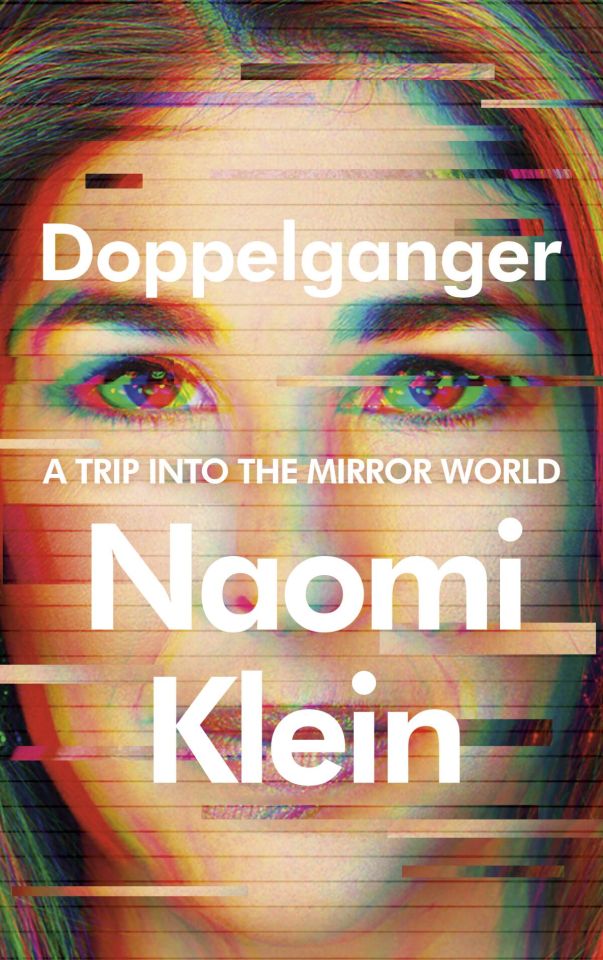
Tomorrow (September 6) at 7pm, I'll be hosting Naomi Klein at the LA Public Library for the launch of Doppelganger.
On September 12 at 7pm, I'll be at Toronto's Another Story Bookshop with my new book The Internet Con: How to Seize the Means of Computation.

If the Naomi be Klein
you’re doing just fine
If the Naomi be Wolf
Oh, buddy. Ooooof.
I learned this rhyme in Doppelganger, Naomi Klein's indescribable semi-memoir that is (more or less) about the way that people confuse her with Naomi Wolf, and how that fact has taken on a new urgency as Wolf descended into conspiratorial politics, becoming a far-right darling and frequent Steve Bannon guest:
https://us.macmillan.com/books/9780374610326/doppelganger
This is a very odd book. It is also a very, very good book. The premise – exploring the two Naomis' divergence – is a surprisingly sturdy scaffold for an ambitious, wide-ranging exploration of this very frightening moment of polycrisis and systemic failure:
https://www.youtube.com/watch?v=lCjcwVhFhTA
Wolf once had a cluster of superficial political and personal similarities to Klein: a feminist author of real literary ability, a Jewish woman, and, of course, a Naomi. Klein grew accustomed to being mistaken for Wolf, but never fully comfortable. Wolf's politics were always more Sheryl Sandberg than bell hooks (or Emma Goldman). While Klein talked about capitalism and class and solidarity, Wolf wanted to "empower" individual women to thrive in a market system that would always produce millions of losers for every winner.
Fundamentally: Klein is a leftist, Wolf was a liberal. The classic leftist distinction goes: leftists want to abolish a system where 150 white men run the world; liberals want to replace half of those 150 with women, queers and people of color.
The past forty years have seen the rise and rise of a right wing politics that started out extreme (think of Reagan and Thatcher's support for Pinochet's death-squads) and only got worse. Liberals and leftists forged an uneasy alliance, with liberals in the lead (literally, in Canada, where today, Justin Trudeau's Liberal Party governs in partnership with the nominally left NDP).
But whenever real leftist transformation was possible, liberals threw in with conservatives: think of the smearing and defenestration of Corbyn by Labour's right, or of the LibDems coalition with David Cameron's Tories, or of the Democrats' dirty tricks to keep Bernie from appearing on the national ballot.
Lacking any kind of transformational agenda, the liberal answer to capitalism's problems always comes down to minor tweaks ("making sure half of our rulers are women, queers and people of color") rather than meaningful, structural shifts. This leaves liberals in the increasingly absurd position of defending the indefensible: insisting that the FDA shouldn't be questioned despite its ghastly failures during the opioid epidemic; claiming that the voting machine companies whose defective products have been the source of increasingly urgent technical criticism are without flaw; embracing the "intelligence community" as the guardians of the best version of America; cheerleading for deindustrialization while telling the workers it harmed with "learn to code"; demanding more intervention in speech by our monopolistic tech companies; and so on.
It's not like leftists ever stopped talking about the importance of transformation and not just reform. But as the junior partners in the progressive coalition, leftists have been drowned out by liberal reformers. In most of the world, if you are worried about falling wages, corporate capture of government, and scientific failures due to weak regulators, the "progressive" answer was to tell you it was all in your head, that you were an unhinged conspiratorialist:
https://doctorow.medium.com/the-swivel-eyed-loons-have-a-point-3434d7cbfae2
For Klein, it's this failure that the faux-populist right has exploited, redirecting legitimate anger and fear into racist, xenophobic, homophobic, sexist and transphobic rage. The deep-pocketed backers of the conservative movement didn't just find a method to get turkeys to vote for Christmas – progressives created the conditions that made that method possible.
If progressives answer pregnant peoples' concerns about vaccine risks – concerns rooted in the absolute failure of prenatal care – with dismissals, while conservatives accept those concerns and funnel them into conspiratorialism, then progressives' message becomes, "We are the movement of keeping things as they are," while conservatives become the movement of "things have to change." Think here of the 2016 liberal slogan, "America was already great," as an answer to the faux-populist rallying cry, "Make America great again."
When liberals get to define what it means to be "progressive," the fundamental, systemic critique is swept away. Conservatives – conservatives! – get to claim the revolutionary mantle, to insist that they alone are interested in root-and-branch transformation of society.
Like the two Naomis, conservatives and progressives become warped mirrors of one another. The progressive campaign for bodily autonomy is co-opted to be the foundation of the anti-vax movement. This is the mirror world, where concerns about real children – in border detention, or living in poverty in America – are reflected back as warped fever-swamp hallucinations about kids in imaginary pizza restaurant basements and Hollywood blood sacrifice rituals. The mirror world replaces RBG with Amy Coney-Barrett and calls it a victory for women. The mirror world defends workers by stoking xenophobic fears about immigrants.
But progressives let it happen. Progressives cede anti-surveillance to conservatives, defending reverse warrants when they're used to enumerate Jan 6 insurrectionists (nevermind that these warrants are mostly used to round up BLM demonstrators). Progressives cede suspicion of large corporations to conservatives, defending giant, exploitative, monopolistic corporations so long as they arouse conservative ire with some performative DEI key-jingling. Progressives defend the CIA and FBI when they're wrongfooting Trump, and voting machine vendors when they're turned into props for the Big Lie.
These issues are transformed in the mirror world: from grave concerns about real things, into unhinged conspiracies about imaginary things. Urgent environmental concerns are turned into a pretense to ban offshore wind turbines ("to protect the birds"). Worry about gender equality is transformed into seminars about women's representation in US drone-killing squads.
For Klein, the transformation of Wolf from liberal icon – Democratic Party consultant and Lean-In-type feminist icon – to rifle-toting Trumpling with a regular spot on the Steve Bannon Power Hour is an entrypoint to understanding the mirror world. How did so many hippie-granola yoga types turn into vicious eugenicists whose answer to "wear a mask to protect the immunocompromised" is "they should die"?
The PastelQ phenomenon – the holistic medicine and "clean eating" to QAnon pipeline – recalls the Nazi obsession with physical fitness, outdoor activities and "natural" living. The neoliberal transformation of health from a collective endeavor – dependent on environmental regulation, sanitation, and public medicine – into a private one, built entirely on "personal choices," leads inexorably to eugenics.
Once you start looking for the mirror world, you see it everywhere. AI chatbots are mirrors of experts, only instead of giving you informed opinions, they plagiarize sentence-fragments into statistically plausible paragraphs. Brands are the mirror-world version of quality, a symbol that isn't a mark of reliability, but a mark of a mark, a sign pointing at nothing. Your own brand – something we're increasingly expected to have – is the mirror world image of you.
The mirror world's overwhelming motif is "I know you are, but what am I?" As in, "Oh, you're a socialist? Well, you know that 'Nazi' stands for 'National Socialist, right?" (and inevitably, this comes from someone who obsesses over the 'Great Replacement' and considers themself a 'race realist').
This isn't serious politics, but it is seriously important. "Antisemitism is the socialism of fools," its obsession with "international bankers" the mirror-world version of the real and present danger from big finance and private equity wreckers. And, as Klein discusses with great nuance and power, the antisemitism discussion is eroded from both sides: both by antisemites, and by doctrinaire Zionists who insist that any criticism of Israel is always and ever antisemetic.
As a Jew in solidarity with Palestinians, I found this section of the book especially good – thoughtful and vigorous, pulling no punches and still capturing the discomfort aroused by this deliberately poisoned debate.
This thoughtful, vigorous prose and argumentation deserves its own special callout here: Klein has produced a first-rate literary work just as much as this is a superb philosophical and political tome. In this moment where the mirror world is exploding and the real world is contracting, this is an essential read.
I'll be Klein's interlocutor tomorrow night (Sept 6) at the LA launch for Doppelganger. We'll be appearing at 7PM at the @LAPublicLibrary:
https://lafl.org/ALOUD
Livestreaming at:
https://youtube.com/live/jIoAh-jxb2k

If you'd like an essay-formatted version of this post to read or share, here's a link to it on pluralistic.net, my surveillance-free, ad-free, tracker-free blog:
https://pluralistic.net/2023/09/05/not-that-naomi/#if-the-naomi-be-klein-youre-doing-just-fine

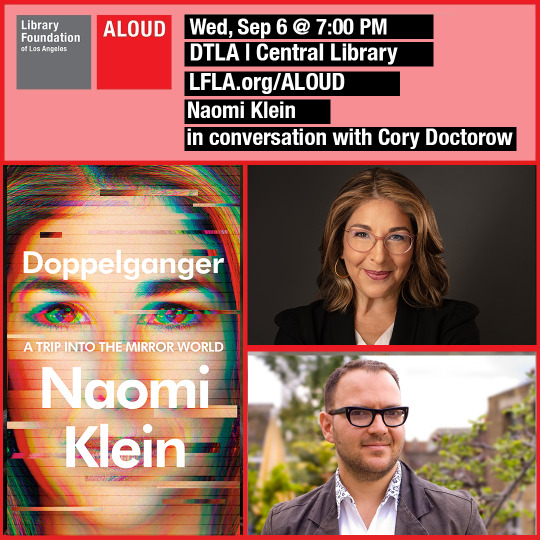
#naomi klein#naomi wolf#conspiratorialism#climate#shock doctrine#race#antisemitism#gender#feminism#books#reviews#no logo#corporatism#heel turns#realignment#power#leftism vs liberalism#gift guide#rabbit holes#memoir#israel#zionism#pluralistic
273 notes
·
View notes
Text
I Miss The Case Study of Vanitas Because Sex

Okay, please forgive me for the clickbait-y title, but I just had to take it. The whiplash is too fun to me. Anyways, yes, I miss The Case Study of Vanitas (both as an anime and manga, since we've not gotten vol 10 in English yet) because of sex. Not the act in and of itself, but the appeal, the tension, the experience. Animanga isn't nearly as sexless as North American media, but it presents its own unique challenges and issues. So, if you don't mind, please humor my little foray into an attempt to explain the decoupling of fan service and sex appeal, with The Case Study of Vanitas as a medium.
⚠️Warning: I've done my best to keep it spoiler free, but by nature there is mild spoilers in regards to characters and certain interactions.⚠️
Is The Case Study of Vanitas about sex? Well, obviously not, no, it's about vampires. But as much as it's about vampires, it's also about despair, hope, penance and revenge, and the intricacies of the human condition. It just happens to feature vampires as the selling point. And I believe therein lies the best explanation of Vanitas: it's not about sex, but rather contains those aspects as a part of the people that exist in its world.
Fanservice has become a rather perverted term. Rather than appealing to a broad range of applications, fanservice tends to exclusively apply to displays that are sexual in nature (most typically in regards to catering to male audiences). In that way it's not particularly awful in how the term itself has shifted, but the use of fanservice is borderline pathetic in most series. A gaudy display of body parts, it hangs on excessive scale and movement to catch the eyes of touch starved individuals. I don't need a ballooned bosom besetting my vision before bobbing about in a baroque display for all too long. That's not the point.
But what is the point? Well, I've prattled on long enough so here's an example.

A look in the eyes, the right lighting. Even simple posing. Sex appeal is not limited to explicit displays of sexuality, but is rather the personification of both the character's intent as well as their external perception.
There are so many moments in this series that are in no way explicitly sexual, but can easily be perceived to have sex appeal or sexual tension.
But then, how would that appeal not feel weakened? It's a good question, honestly, and an important one to ask. When you display the chest of an underaged girl enough times, it won't elate the audience enough to be perceived as "good". It's a universal issue with storytelling, so how does Vanitas get around it?
My answer (and perhaps not the only answer) is how this appeal and tension is derived. I had sort of said it earlier, but didn't really explain. Its source is the very nature of the characters and world. It is not an external force exposing these facets, but the machinations of the plot and its pieces themselves.
Have a look at this example here. Vampires are hot, right? Their power, broody nature, and the concept of the unknown have played into their eroticism and appeal since time immemorial (seriously, look up Carmilla). Vanitas pounces on that concept and immediately plays into it. We don't get blood sucking every episode and every second, no. But we get it enough to provide variation, it appears at the right time to provide another layer to the nature of the story and characters.
Anyways, the example. Lord Ruthven and Noe. Two vampires, engaging in something strictly non-sexual. He is simply biting Noe. But the posing, the nature of the layout. It presents tension. It presents Ruthven's ownership and commanding nature of Noe in this moment. Domination and subjugation.
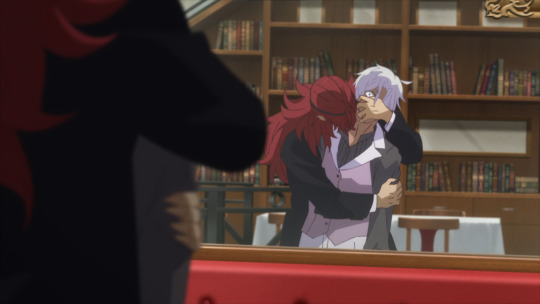
Even more is this sequence. The commanding nature that presents a clear power dynamic. The phrasing. It absolutely exudes sexual tension. But nothing of the sort is apparent in the actual interaction.

So what's the deal here. I know I had spoken on how characters themselves can convey tension and appeal without explicit intent to do so, but how can circumstance and interaction play into it as well?
Another lovely question. What comprises the act of sex? What are the pieces that elate, entice, and encourage someone? Well, aside from the answer that it's down to the individual, there's a few core pieces. The "top and bottom" dynamic is certainly the one that appears the most when dealing with pairs. Another, while a bit unseemly and slightly (?) taboo is the concept of fear and violence. Of course, I don't mean in any serious context, but the concept is how those things make you feel, and that they stem from that similar power dynamic. Perhaps that's the best word to describe it with: power dynamic. It's all about how two characters interact with each other, where they stand in relation to one another. The above image is the perfect example of that, and the following is how to build on it.
Vanitas and Jeanne, an incredible combination born not out of a mutual desire for the other, but the sheer interest of one and the needs of another. It's a one sided love spurred on by the actions of one that encourages the other to let loose. It creates the interesting dynamic of a power bottom that remains refreshing alongside the other relationships that exist in the story.
So here's a clip of that dynamic.
The way the camera and characters hang on each moment, the way the layouts aim to both obstruct but also apply razor focus. The voice acting. All of it, every single moments provides for that tension and appeal, and it extends past the act of sucking blood and into the souls of the characters themselves. A terrible plead that spills from blood stained lips, a promise that comes from the origin of that crimson.
This "sex appeal" and "sexual tension" is not something manufactured, but the absolute core of these characters. The act of domination, the incredible an undesired need of a substance, the mental fractures eroding at the ego of a person. All of these moments stem from the very souls of the characters and bubble up to the surface in these forms of expression. Where words will not do, actions speak in their place.
Also, Vanitas moaning. Yes please. The greatest benefit to this series is the fact that it's willing to lean into the men as well. This is not "just" for the guys (and lesbians), no. This is for everyone, but especially those that enjoy a side of insanity and toxicity to their romance.
So that brings us to the end. Vanitas is not "about" sex, Vanitas is sex and is the purest way to deliver on fan service while providing sexual tension and appeal. It's subtle, subdued, infrequent and benign. It does not bend to the desires of the viewer, but rather stems from those of the characters. And so many series need to take note. "Lucky Lecher" and perversely excessive displays have no home in my heart when there are far more artistic and desirable sequences that can be produced.
#vanitas no carte#the case study of vanitas#vanitas of the blue moon#les memoires de vanitas#vanitas jeanne#vnc vanitas#jeanne the hellfire witch#dominique de sade#vanoe#noe archiviste#august ruthven#lord ruthven#vnc jeanne#vanijeanne#vnc#anime and manga#anime#manga#anime recommendation#anime review#manga reccs#manga recommendation#manga review
210 notes
·
View notes
Text
A Natural History of Dragons, by Marie Brennan
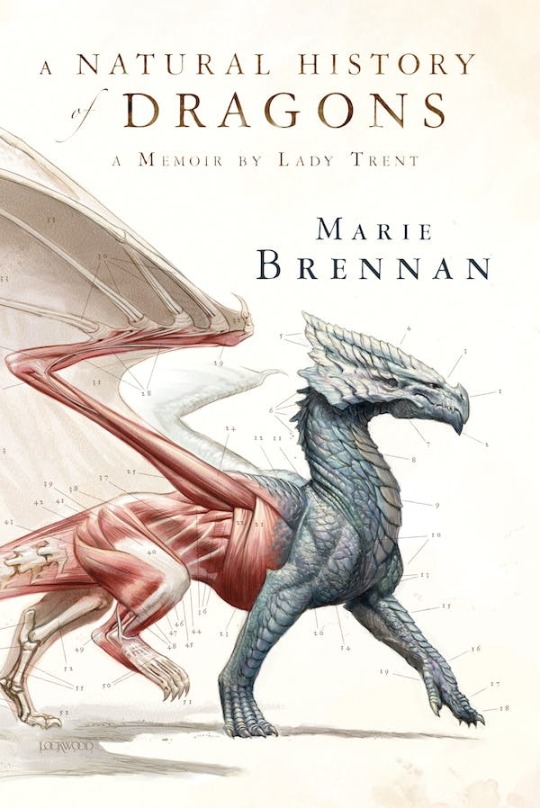
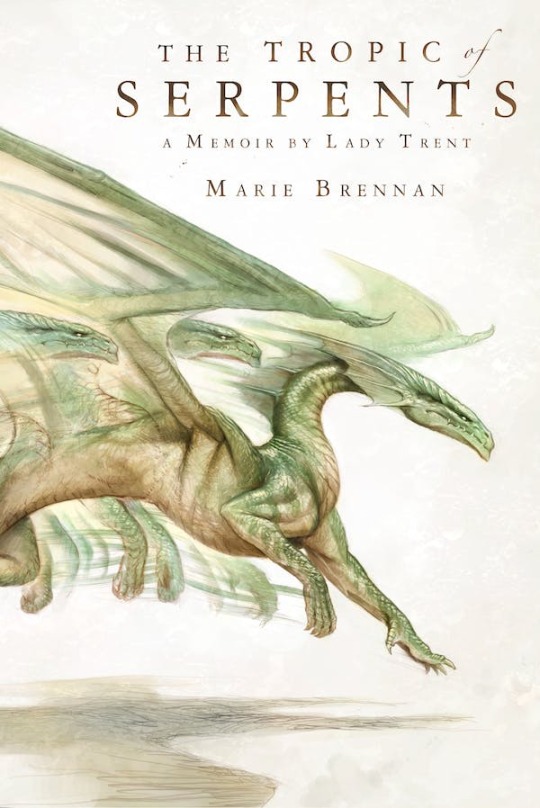
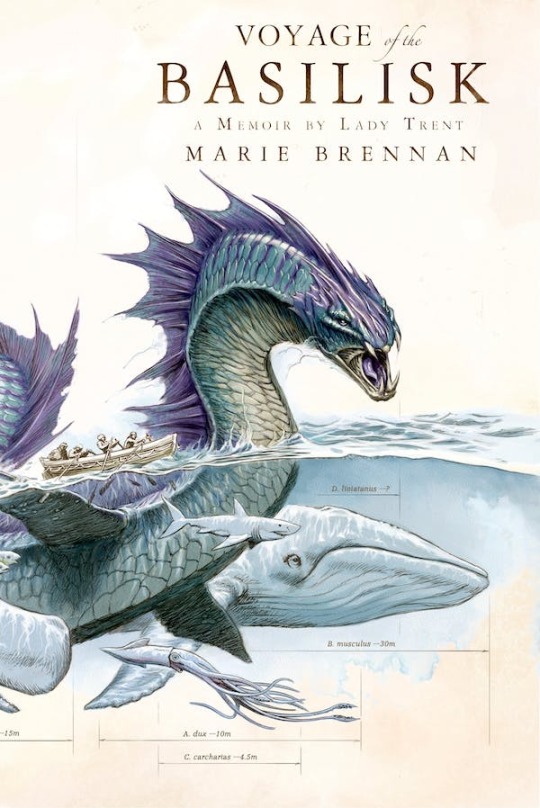
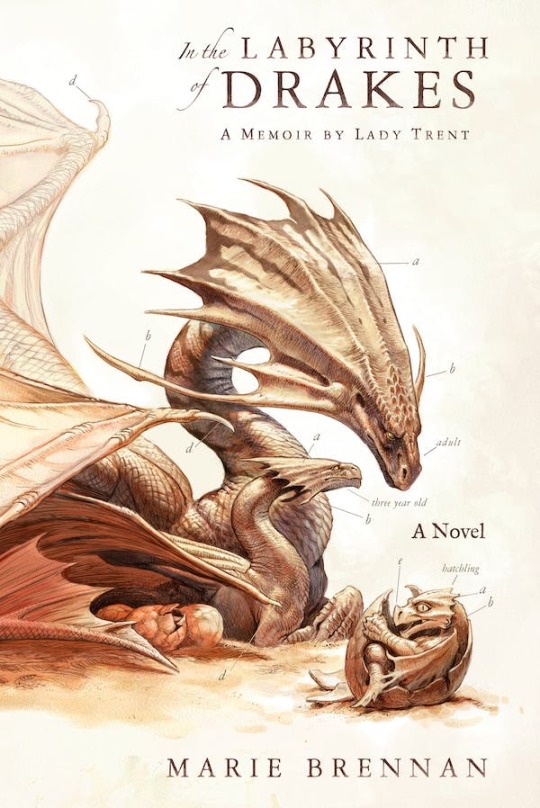
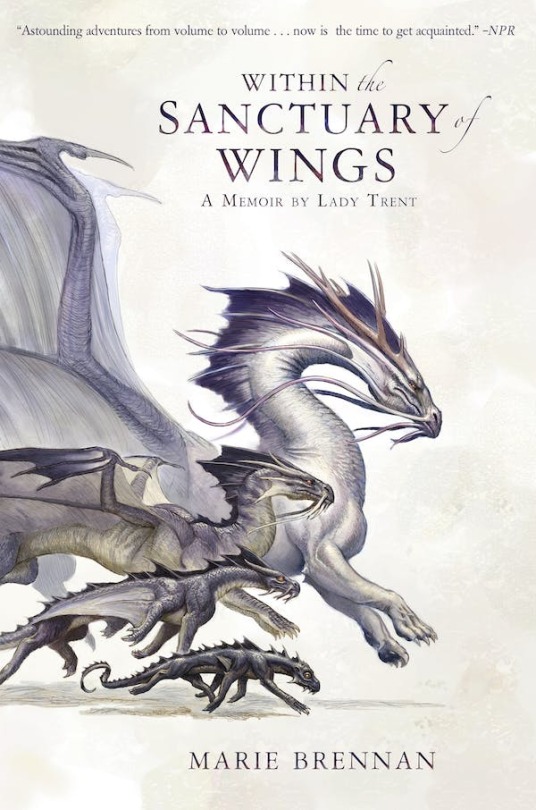
The memoirs of Lady Trent narrate the life and research of Isabella Trent, world-renowned naturalist now an old woman, whose wit and humor are merciless towards imbeciles.
In the first tome, Isabella, first as a young girl and then a young woman, challenges class and period conventions to satisfy her scientific curiosity and accompany her husband on an expedition in search for dragons in Vystrana...
I was scared that the memoirs format was going to be boring to read, but it was actually the best way to tell the life story of a woman who has lived so many adventures, I really liked it. The good thing about memoirs is that it allowed Isabella's personality to shine, especially her humor, and to have some hindsight on what happened. The teases about future events that she reveals later in the series really make you want to read what's next
Volume 1 introduces themes and ideas that I thought were fleshed out better later in the series, and what I considered as small flaws (a lot of things were repeated so many times I started thinking "yeah, okay, I get it") are way less prominent
As for Brennan's worldbuilding, it's deceptively simple at first glance (Victorian era but make it fantasy), but actually had so many details that make it extremely rich. Everything is inspired by countries/cultures from the real world, but Brennan mixed a lot of them and I thought it was really well executed. And the further along you get in the series, the more details sprinkled in the first 3 books come together to form the final picture. When I got to the end of book 4, I wanted to scream because of how delightful and well put together the reveals were
French version under the cut
Les mémoires de lady Trent racontent la vie et les recherches d'Isabelle Trent, naturaliste mondialement connue et désormais vieille dame, dont l'esprit et le style empreints d'humour s'avèrent sans pitié pour les imbéciles.
Dans le premier volume, Isabelle, petite fille puis jeune femme, brave les conventions de sa classe et de son temps pour satisfaire sa curiosité scientifique et accompagner son mari lors d'une expédition à la recherche des dragons de Vystranie...
J'avais peur que le format des mémoires soit un peu ennuyant à lire, mais en fait c'était la meilleure façon de raconter la vie d’une femme qui a vécu autant d’aventures, j’ai beaucoup apprécié. L'avantage des mémoires c'est que ça permettait au personnage d'Isabelle de nous dévoiler sa personnalité, notamment son humour, et d'avoir du recul sur certains évènements. Les références à des évènements qu'elle nous dévoile plus tard dans la série donnait vraiment envie de lire la suite
Le tome 1 introduit des thèmes et des idées que j’ai trouvées mieux développées dans les tomes suivants, et ce que je considérais comme de petits défauts (pas mal de choses sont répétées de nombreuses fois donc au bout d’un moment je me disais "oui, c’est bon, j’ai compris") sont beaucoup moins présents
En ce qui concerne le monde créé par Brennan, il paraît relativement simple au premier abord (époque victorienne mais version fantasy), mais en réalité, énormément de détails le rendent extrêmement riche. Tout est inspiré de pays/cultures du monde réel, mais mélange pas mal de trucs et j’ai trouvé que c’était très bien fait. Et au plus on avance dans la série, au plus les détails disséminés dans les ~3 premiers tomes s'emboîtent et le tableau final se précise. Quand je suis arrivée à la fin du tome 4 j'avais envie de hurler tellement les révélations étaient croustillantes et bien amenées
#the memoirs of lady trent#lady trent#a natural history of dragons#memoirs of lady trent#marie brennan#books#book series#book reviews#booklr#booklr community#book recs#book recommendations
89 notes
·
View notes
Text
in the middle of watching the new quinton reviews sam & cat video and it always frustrates me when his stuff gets put into that category of “just recap not analysis” by people. I understand why those nickelodeon vids aren’t for everyone I really do but I’d still argue what quinton does is analysis - not necessarily of the show itself but rather everything around it. it’s analysis of the cultural moment that was icarly or victorious or sam & cat because that’s the most interesting parts of these shows, not necessarily their actual content (they’re literally children’s sitcoms)
like I was pretty strictly a cartoon network kid growing up, I never watched any of these shows when I would’ve been in the target demographic and honestly to this day I haven’t actually watched a single episode of any of them nor do I have much desire to, however, watching quinton’s videos on them I feel like I have a genuine understanding of them as phenomenons. I understand their appeal, why some of them took off more than others, why they’re remembered fondly by people, the relationship audiences have had with them at the time etc. and I think diving into those aspects should be considered analysis just as much as an actual narrative deep dive. it’s simply a different type of analysis. and I can’t think of any other video series I’ve seen on youtube do that. it feels like a really unique experience.
I know that “long recaps of media you watched in your childhood and/or teen years” has become a genre and arguably took off when quinton’s videos started doing really well but I can’t stress enough that his videos are not that: the recaps are only a relatively small part all things considered. hell the video before this one barely contained any recaps at all. where I’m at in this video currently the recaps have completely finished and I still have four hours to go. and I think that’s also the reason why I really love his videos but otherwise can’t get into that whole genre.
#shut up abe#quinton reviews#also if I didn’t watch those vids I never would have never listened to jenette mccurdy’s memoir last year#that alone makes them count for something
63 notes
·
View notes
Text
I'm glad my mom died by Jennette McCurdy - Review

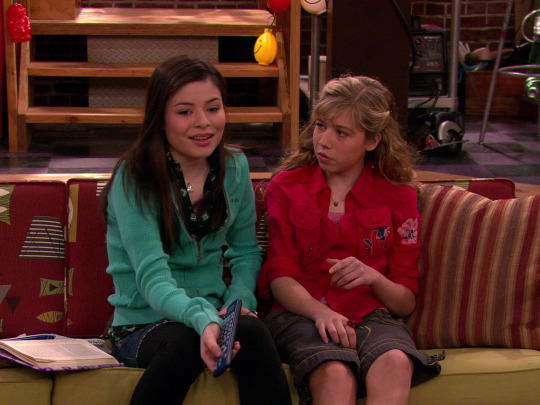
rating: ⭐⭐⭐⭐⭐ (5)
I’m glad my mom died tells the story of Jennette McCurdy’s relationship with her mother and her path towards becoming an actress and later dealing with the trauma her mother helped inflict on her.
This book deals with themes such as abusive parents, anorexia, bulimia, anxiety, panic attacks and it implies rape and sexual abuse in the workplace.
Prior to my reading I had seen a few episodes of iCarly, however I wasn’t an avid watcher, I tuned in to Disney Channel more. Therefore I went to this book not knowing much about Jennette’s life.
The marketing for this book might have been misleading to some, it was said to be a heartbreaking and funny memoir. While Jennette’s voice as the narrator can be witty, it is mostly provocative, challenging you to react and oppose to what is bring shown. The things that happen are horrifying, sad and at times hopeless.
Speaking of Jennette’s voice, this book is narrated through her perspective as she grows up. Her inner voice changes and evolves throughout the memoir as we see her go through changes. This type of narration worked really well here, it makes it more brutal but also honest. We could see how the things her mom did to her affected her in real time, instead of only reflecting on the trauma she left behind. We also see her slowly coming to terms that she was abused, and I think had she gone a different route and write this solely based on her present self perspective, it wouldn’t have been as impactful.
“I've spent my whole life studying her so that I can always know, because I always want to do whatever I can in any given moment to keep or make Mom happy.”
The relationship Jennette has with her mother is codependent, hurtful and scary. She has no autonomy over her life, her decisions or her tastes because she’s busy trying to please her mother. She carries very heavy weight of responsibility to make her mom happy, she makes sacrifices no child should do to make that happen.
Her mother is no different, she’s very codependent on Jennette, citing her as her best friend multiple times. She wants to be around her daughter at all times and control every aspect of her life. She knows Jennette so well she can use her words to hurt (which she does in adult Jennette’s life) or to comfort.
"I don't want to act anymore," I say before I even realize I've said it.
(…)
"Don't be silly, you love acting. It's your favorite thing in the world," Mom says in a way that makes it sound like a threat.
(…)
"No, I really don't want to. I don't like it. It makes me uncomfortable."
Mom's face looks like she just ate a lemon. It contorts in a way that terrifies me. I know what's coming next.
"You can't quit!" she sobs. "This was our chance! This was ouuuuur chaaaaance!"
She bangs on the steering wheel, accidentally hitting the horn. Mascara trickles down her cheeks. She's hysterical, like I was in the Hollywood Homicide audition. Her hysteria frightens me and demands to be taken care of.
"Never mind," I say loudly so Mom can hear it through her sobs.
Her crying stops immediately, except for one leftover sniffle, but as soon as that sniffe is over, it's complete silence. I'm not the only one who can cry on
cue.
Jennette does a very good job in choosing specific scenes to make a point across. She does one of the things I love the most in literature. Show don’t tell. Some scenes are short but powerful, aiming to show us her mother’s sadistic behaviour, leaving Jennette’s anxiety levels to rise up.
Her mother wanted her to act and she manipulated her until she died just so she could continue that job, the excerpt above is one of the examples of that manipulation happening.
If I start to grow up, Mom won't love me as much. She often weeps and holds me really tight and says she just wants me to stay small and young.
(…)
I'm determined to not grow up. 'll do anything to stop it from happening.
"Well, is there anything I could do to stop the boobies from coming in?" I ask Mom nervously.
(…)
Mom is grateful-happy.
(…)
"Well, sweetheart, if you really want to know how to stay small, there's this secret thing you can do... i's called calorie restriction."
When I read that passage I had to put the book down and scream into the void.
A big theme this book addresses is eating disorders, Jennette’s issues with food start when she’s eleven years old and her mother incentives her to calorie restriction. It’s a very graphic part of the book and possibly the most disturbing. Jennette goes into great detail in how she and her mother planned and prepped her foods (or lack of) and how they measured her weight. It also shows her mother’s careless comments about her body, making her relationship with food even worse. When she starts developing bulimia it is graphic, horrifying and if you’re someone that struggles with this, this might not be the book for you. I thought it was too much, but maybe it was necessary for her to get specific, so we could really understand.
The book doesn’t go into great detail about her time on iCarly and Sam&Cat and it didn’t need to. I understand fans would love behind the scenes, but ultimately this memoir was about her traumas with her mother.
Jennette tells us about “The Creator” and how her workplace was abusive. She speaks about the anxiety and unhappiness she felt when shooting the series, them not letting her direct and episode in Sam&Cat and her friendships that outlasted the show.
She also speaks on how fame affected her and how much she loathe it. This book starts great conversations about the ethics behinds child actors and how much the work conditions fail them.
Sometimes when I miss her I start to fantasize about what life would be like if she were still alive and I imagine that maybe she'd have apologized, and we'd have wept in each other's arms and promised each other we'd start fresh. Maybe she'd support me having my own identity, my own hopes and dreams and pursuits.
But then I realize I'm just romanticizing the dead in the same way I wish everyone else wouldn't.
The book ends with Jennette enrolling into therapy (god bless) and her path to healing. It’s a tough road but she’s making progress. In the end she comes to terms that she can love her mom while admitting she was abusive to her and I feel like that’s a very nice way to close such a tragic and horrifying story.
#booklr#books & libraries#book review#book quotes#books#literature#reading#my reviews#jennette mccurdy#i'm glad my mom died#book recommendations#book reccs#trauma#memoir#nonfiction
25 notes
·
View notes
Text

Gender Queer by Maia Kobabe
I am not a huge memoir reader, but you can bet that if it's a graphic memoir I will pick it up, plus I want to expand my queer book collection, and this book was an amazing addition, that I know I will reread in the future. The author is non-binary and uses e/em/eir pronouns, which I never had to use before so if I fuck up while writing and editing please let me know. With this being said Gender Queer is a memoir and focuses on the author's journey of getting to know eir own self from a sexuality and gender point of view. But it feels reductive to describe this book as just that. The author does a great job at telling the story of eir life without skipping on all the existential crisis, the confusion and the fear. It's a very raw and honest work in my opinion, and it's amazing just because of that. Em couldn't have done a better job at explaing this complicated journey with all its ups and downs. There's fear and confusion, but also joy in getting to understand yourself more. It doesn't skip on any kind of thought, there's a few points that hit so close to home, ans that will keep sparking thoughts. The way the author talkes about gender and eir way of presenting is incredibly clever. I particularly liked how em used a landscape to talk about gender. It's not easy to put into words how good this graphic memoir is, and the fact that it was banned so much is scary and should be a good enough reason to pick it up. I feel like this could be a great way to let non-queer people understand a little better how figuring these things about yourself is, and how complex it gets. It's a little like being in the author's head sometimes, which is why I feel like this could be a great tool for queer allies to understand some things on a deeper level. As a queer person who is actually pondering a lot of these questions, it was very comforting to read about someone who stuggled just as much, but honestly reminds you of how layered and complicated these things are. Additionally I really liked the illustrations, the colour palette felt nice and overall I just really liked the look of this book (I should mention my edition which is the Italian on wasn't as curated as it should have because a few pages were blurred to a point you couldn't clearly read, which is absolutely unacceptable especially for how expensive graphic novels are. I never had such problems with this publisher, but that was kinda disappointing because I expected a bit more cure on the details, but again that is the Italian publisher's fault).
I read this for the jumbo reading challenge non binary author prompt.
#book#books#2023 book#bookblr#booklr#queer book#gender queer#maia kobabe#memoir#book rec#book review#book recommendation#book cover#reading#bookish#mine#the---hermit
59 notes
·
View notes
Text
Listen okay, I don’t like to read, but oh my god this book. If you like Southern gothic, Appalachian Gothic, midwestern gothic, anything of that nature, READ THIS MEMOIR. It is the 2nd best book I have ever read in my entire life.

#diary 🦷#booklr#book review#bookblr#books and reading#book recommendations#book reccs#memoir#southern gothic#appalachian gothic#midwestern gothic#rural gothic#rural america#appalachia
45 notes
·
View notes
Text
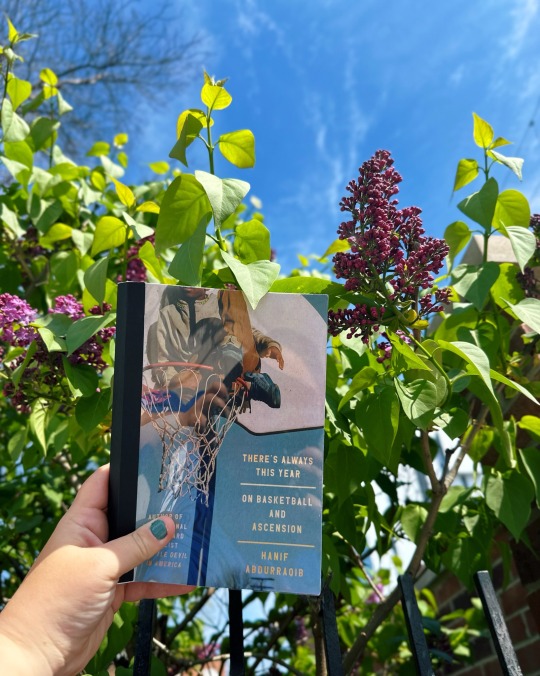
No one writes like Hanif Abdurraqib writes. He has 15 different images and themes he's juggling, and you can follow every one as it flows into the next, and then at the end of a 300 page book, it has all come together, and it has moved you (man had me crying over a LeBron James Nike commercial! I don't even watch men's basketball!)
There's Always This Year: On Basketball and Ascension is about basketball, about how sports hit us in all the most vital places, in basketball's role in Abdurraqib's childhood growing up in the hood in Columbus, Ohio. It is about LeBron James and his rise (he is about the same age as the author), a rise the author witnessed, and his connection to the city, to the state of Ohio. It is about coming of age Black, in a neighborhood that other people have Opinions about, in a neighborhood policed. It's about growing up, about shame and survival, about longing and loss, and about how it is a privilege simply to age, to see the greys grow. It is about being tethered to a place, part of a place, in love with a city, and it is about leaving, and heartbreak, and returning.
And most of all, it's about all of those things jumbled together into one, poetic flow of a book that will move you (and no, you don't need to know anything about the NBA to appreciate a moment of it, though I'm sure reading a lil Wikipedia about James wouldn't hurt if you're unfamiliar). I wish, often, that I could write like Abdurraqib writes. He has a gift unlike anyone else for putting emotion into words. What it feels like to believe in a sports team. What it means to protest knowing that the end isn't you "winning." The feeling that an infinite looping fadeaway end to a song leaves you with. The multitude of ways that heartbreak and hope can live in a person, so often both at once. This book is evocative, moving, and beautiful—and if you're worried I'm hinting that it's dense, please don't be worried. I don't think you'll be able to put it down.
Content warnings for suicidal ideation, police brutality, violence, death/grief.
18 notes
·
View notes
Text
Queer Sex: A Trans and Non-Binary Guide to Intimacy, Pleasure and Relationships by Juno Roche
goodreads
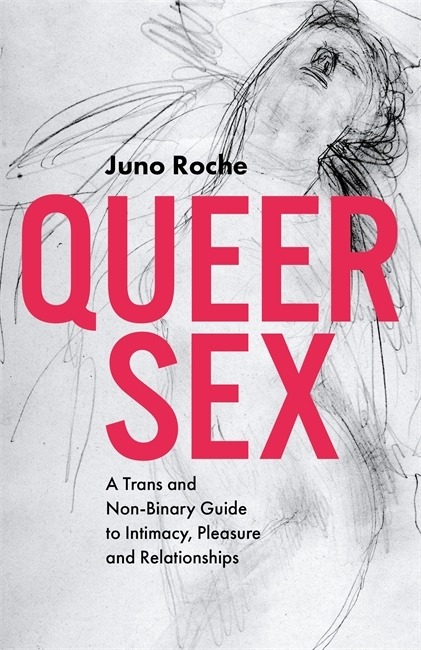
In this frank, funny and poignant book, transgender activist Juno Roche discusses sex, desire and dating with leading figures from the trans and non-binary community. Calling out prejudices and inspiring readers to explore their own concepts of intimacy and sexuality, the first-hand accounts celebrate the wonder and potential of trans bodies and push at the boundaries of how society views gender, sexuality and relationships. Empowering and necessary, this collection shows all trans people deserve to feel brave, beautiful and sexy.
Mod opinion: I haven't heard of this book before, but it sounds really interesting, especially since it deals with transgender sexuality, which is always an interesting topic to me.
#queer sex#juno roche#polls#trans lit#trans literature#trans books#lgbt lit#lgbt literature#lgbt books#memoir#nonfiction#to read#trans woman#according to the reviews theres a bigger focus on trans female sexuality so im tagging this here extra in case its interesting to someone
21 notes
·
View notes
Text

“I’m Glad My Mom Died” by Jennette McCurdy
I read this book back in august but forgot I request it from my library and it just arrived ! The holds list is insane and rightfully so because this book was a 5/5 ⭐️ for me. Jennette is an incredible storyteller and was extremely honest in her New memoir. She writes about the abuse she had to endure from her mother and the Hollywood industry beginning from a very young age up until adulthood. As someone who watched ICarly growing up it was shocking to find out what was going on behind the scenes in Jennette’s life. It really opened my eyes and I admire Jennette for sharing her story. I highly recommend this book but as always please check trigger warnings.
Follow me on Insta @ ReadingBySunlight
#books#novel-goddess#booklr#novel goddess#reading#novels#book photography#i’m glad my mom died#jennette mccurdy#memoir#book review#book recommendations#book release#reader#library#shelf#book shelf
296 notes
·
View notes
Text
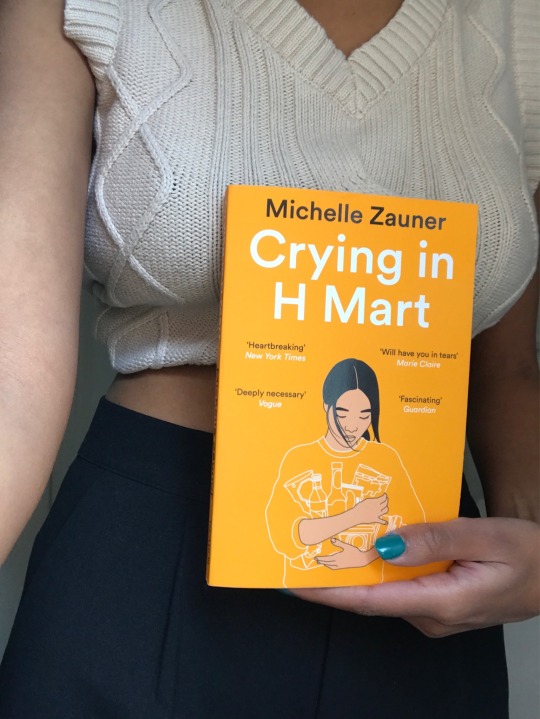



non-fiction november read & treat yo self moments. crying in h mart was an emotional read and beautifully written. it’s main themes are mother-daughter relationships & connecting to culture through food (so of course I was craving korean food throughout) it also made me reflect on my own relationship with my mum. overall an heartfelt memoir —5 stars
#reading list#currently reading#non fiction books#memoir#book stack#book blog#booklover#books#book review#bookshelf#bookblr#reading#studyblr#bujo#bullet journal#journal#study aesthetics#book aesthetic#light aesthetic#korean food#glossyhobi
161 notes
·
View notes
Text
Kate Beaton's "Ducks"
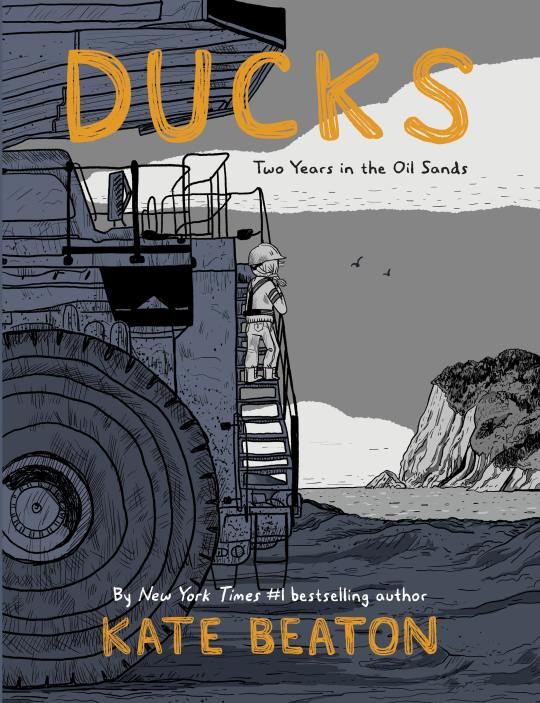
It’s been more than a decade since I began thrilling to Kate Beaton’s spectacular, hilarious snark-history webcomic “Hark! A Vagrant,” pioneering work that mixed deceptively simple lines, superb facial expressions, and devastating historical humor:
https://memex.craphound.com/2012/03/23/hark-a-vagrant-the-book/
Beaton developed Hark! into a more explicit political allegory, managing the near-impossible trick of being trenchant and topical while still being explosively funny. Her second Hark! collection, Step Aside, Pops, remains essential reading, if only for her brilliant “straw feminists”:
https://memex.craphound.com/2015/09/15/step-aside-pops-a-new-hark-a-vagrant-collection-that-delights-and-dazzles/
Beaton is nothing if not versatile. In 2015, she published The Princess and the Pony, a picture book that I read to my own daughter — and which inspired me to write my own first picture book, Poesy the Monster-Slayer:
https://memex.craphound.com/2015/08/07/the-princess-and-the-pony-from-kate-hark-a-vagrant-beaton/
Beaton, then, has a long history of crossing genres in her graphic novels, so the fact that she published a memoir in graphic novel form is no surprise. But that memoir, Ducks: Two Years In the Oil Sands, still marks a departure for her, trading explosive laughs for subtle, keen observations about labor, climate and gender:
https://drawnandquarterly.com/books/ducks/
In 2005, Beaton was a newly minted art-school grad facing a crushing load of student debt, a debt she would never be able to manage in the crumbling, post-boom economy of Cape Breton, Nova Scotia. Like so many Maritimers, she left the home that meant everything for her to travel to Alberta, where the tar sands oil boom promised unmatched riches for anyone willing to take them.
Beaton’s memoir describes the following four years, as she works her way into a series of oil industry jobs in isolated company towns where men outnumber women 50:1 and where whole communities marinate in a literally toxic brew of carcinogens, misogyny, economic desperation and environmental degradation.
The story that follows is — naturally — wrenching, but it is also subtle and ambivalent. Beaton finds camaraderie with — and empathy for — the people she works alongside, even amidst unimaginable, grinding workplace harassment that manifests in both obvious and glancing ways.
Early reviews of Ducks rightly praised it for this subtlety and ambivalence. This is a book that makes no easy characterizations, and while it has villains — a content warning, the book depicts multiple sexual assaults — it carefully apportions blame in the mix of individual failings and a brutal system.
This is as true for the environmental tale as it is for the labor story: the tar sands are the world’s filthiest oil, an energy source that is only viable when oil prices peak, because extracting and refining that oil is so energy-intensive. The slow, implacable, irreversible impact that burning Canadian oil has on our shared planet is diffuse and takes place over long timescales, making it hard to measure and attribute.
But the impact of the tar sands on the bodies and minds of the workers in the oil patch, on the First Nations whose land is stolen and despoiled in service to oil, and on the politics of Canada are far more immediate. Beaton paints all this in with the subtlest of brushstrokes, a thousand delicate cuts that leave the reader bleeding in sympathy by the time the tale is told.
Beaton’s memoir is a political and social triumph, a subtle knife that cuts at our carefully cultivated blind-spots about industry, labor, energy, gender, and the climate. But it’s also — and not incidentally — a narrative and artistic triumph.
In other words, Beaton’s not just telling an important story, she’s also telling a fantastically engrossing story — a page-turner, filled with human drama, delicious tension, likable and complex characters, all the elements of a first-rate tale.
Likewise, Beaton’s art is perfectly on point. Hark!’s secret weapon was always Beaton’s gift for drawing deceptively simple human faces whose facial expressions were indescribably, superbly perfect, conveying irreducible mixtures of emotion and sentiment. If anything, Ducks does this even better. I think you could remix this book so that it’s just a series of facial expressions and you’d still convey all the major emotional beats of the story.
Graphic memoirs have emerged as a potent and important genre in this century. And women have led that genre, starting with books like Alison Bechdel’s Fun Home (2006):
https://cbldf.org/banned-challenged-comics/case-study-fun-home/
But also the increasingly autobiographical work of Lynda Barry, culminating in her 2008 One! Hundred! Demons!:
https://drawnandquarterly.com/books/one-hundred-demons/
(which should really be read alongside her masterwork on creativity, 2019’s Making Comics):
https://memex.craphound.com/2019/11/05/lynda-barrys-making-comics-is-one-of-the-best-most-practical-books-ever-written-about-creativity/
In 2014, we got Cece Bell’s wonderful El Deafo:
https://memex.craphound.com/2014/11/25/el-deafo-moving-fresh-ya-comic-book-memoir-about-growing-up-deaf/
Which was part of the lineage that includes the work of Lucy Knisley, especially later volumes like 2020’s Stepping Stones:
https://pluralistic.net/2020/07/09/enhanced-rock-weathering/#knisley
Along with Jen Wang’s 2019 Stargazing:
https://memex.craphound.com/2019/09/25/stargazing-jen-wangs-semi-autobiographical-graphic-novel-for-young-readers-is-a-complex-tale-of-identity-talent-and-loyalty/
2019 was actually a bumper-crop year for stupendous graphic memoirs by women, rounded out by Ebony Flowers’s Hot Comb:
https://drawnandquarterly.com/books/hot-comb/
And don’t forget 2017’s dazzling My Favorite Thing is Monsters, by Emil Ferris:
https://memex.craphound.com/2017/06/20/my-favorite-thing-is-monsters-a-haunting-diary-of-a-young-girl-as-a-dazzling-graphic-novel/
This rapidly expanding, enthralling canon is one of the most exciting literary trends of this century, and Ducks stands with the best of it.
[Image ID: The cover of the Drawn & Quarterly edition of Kate Beaton's 'Ducks.']
#pluralistic#kate beaton#hark a vagrant#tar sands#oil sands#big oil#carbon#climate emergency#memoir#books#graphic novels#alberta#fort mac#fort macmurray#misogyny#boomtowns#gift guide#drawn and quarterly#reviews
191 notes
·
View notes
Text
The Case Study of Vanitas Manga Covers Explained
So, it has come to my attention that some people haven't clued in to the themes and symbolism of all of the covers for The Case Study of Vanitas. So, I am here now to explain the intricacies and important and impressive details of each cover so everyone can appreciate how outstanding these covers are. So without further ado, time to get a little too into something benign and slightly pointless.
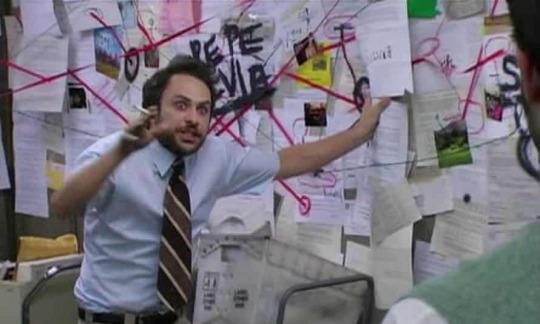
Volume 1
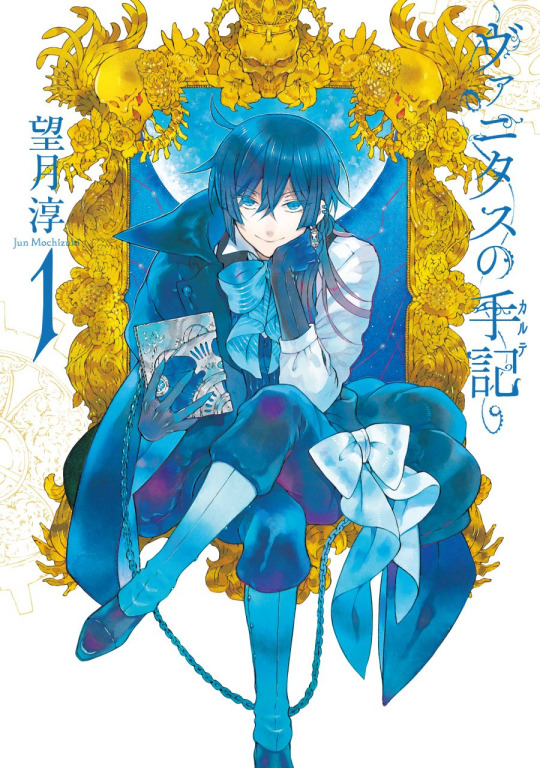
So, allow me to state the obvious first. The "theme" of Vanitas here is Vanitas, as it's an actual painting style that combines vanity (go figure) with death essentially. Putting the opulence of life in opposition with the absolutism of death. You see it with the skull wearing a crown, for one, or the other skeletal figures that decorate the mirror.
Well, I guess I should explain that first, actually. Each cover has a mirror, in one way or another. A look into the characters, a reflection of themselves through both the frame and the actual contents of the mirror.
So anyways, in the mirror, we have the blue moon and the spider's web that we associate with Altus Paris. The undeniable connection that Vanitas has to the Babel Incident, Vampires, and Vanitas of the Blue Moon. As the first volume cover it's very well designed to evoke that connection without giving readers a touch more.
Volume 2

Next up we have Noe (one of my favorite covers). This one is interesting for a few reasons integral to his character as a Vampire. Firstly though, we have the two important bits cresting the the mirror, a pen and paper (to be taken as a journal) and the blue flowers of Noe's childhood with his teacher. They are integral aspects of his character in that he was never afraid of the blue moon like other vampires, and that his family's ability to feel the memories of others through their blood.
Alongside that we have his Teacher in the mirror, hands wrapped around Noe. It's pretty evident symbolism for how much his Teacher has him wrapped around his fingers, and how he's the controlling force within Noe's life. Outside of the mirror though, Noe is covered in blood from drinking it from someone. This is pretty easy to relate to Noe's line about a certain someone's fate, which he mentions within the first volume.
Volume 3
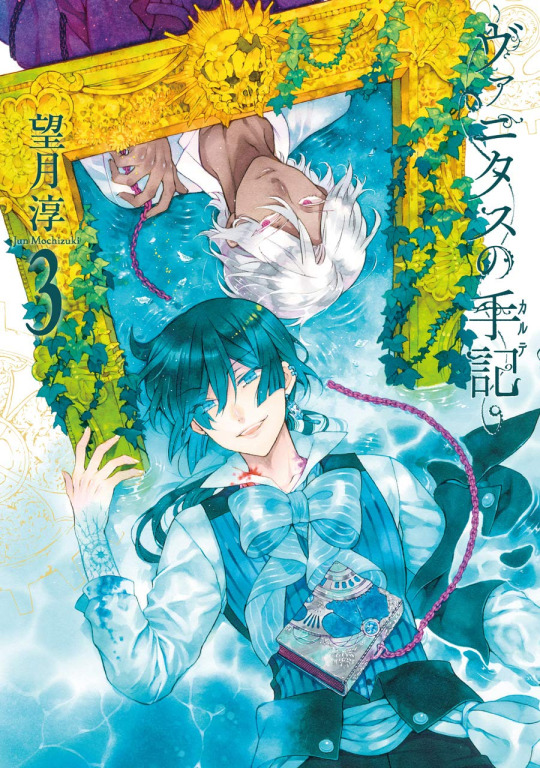
I find this cover particularly interesting, though it is not quite my favorite. Once more we see the Vanitas style applied to the mirror, though this one is special. It's a mirror that goes both ways. We're only seeing it from Vanitas' side. Regardless, Vanitas is both stained with blood and marked, while sharing the chain of the Book of Vanitas with Noe. This is pretty clearly symbolizes the nature of their connection, that Noe is chained to the book rather than Vanitas himself in this case.
Aside from that there's nothing incredibly crazy to it, though the water from the mirror and Vanitas' side disappears on the exterior of the mirror once it passes the plane that the mirror exists on. Essentially, the water only exists in the mirror and on Vanitas' side of it. The same can be said of Noe, as the "rest" of them on the volume is colored completely different.
Volume 4
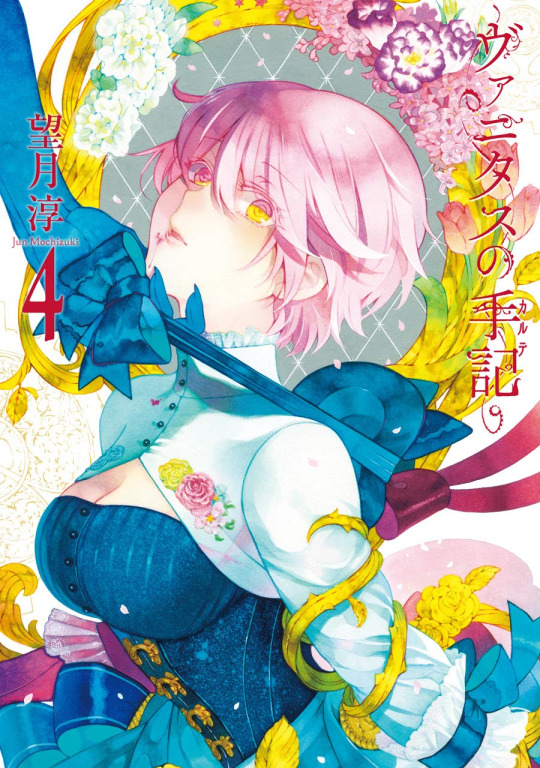
I really love this one. The mirror is decorated with all manner of flowers to make it "pretty", and Jeanne is all dressed up as well. However, her mirror is coiling around her arm, trapping her in place. She's unable to leave it, stuck within it so to speak, eternally struggling to view herself how she so desires. But, we have Vanitas' hand pulling against this. He is there to free Jeanne of her mirror, to free her of the blood-stained thing that she desperately tries to hide.
It's a pretty straightforward theme that doesn't have a great deal to explain, but it has a really incredible amount of depth to it, especially considering the second part of the anime.
Volume 5

This one, this one is very interesting. It's arguably the most unique/divergent of the bunch. It doesn't adhere to quite the same rules as the prior 4, but still conducts itself like it does. I won't act as confident with this one, but I believe this cover to be from within the mirror. Things are as they are, and they are effectively trapped by the Beast of Gévaudan, which hovers menacingly in the background through the mirror.
Most interestingly however is the smaller details. We don't get to see Noe's right hand, and the book of Vanitas is not visible compared to it being featured in both of Vanitas' previous covers. Alongside that, we have the foreshadowing of the cover, with a certain spear covering Vanitas' leg. It's very well done and impressively creative, but is just a little too divergent from the rest for me to really sell my standpoint on it, so there's certainly room for personal interpretation here.
Volume 6
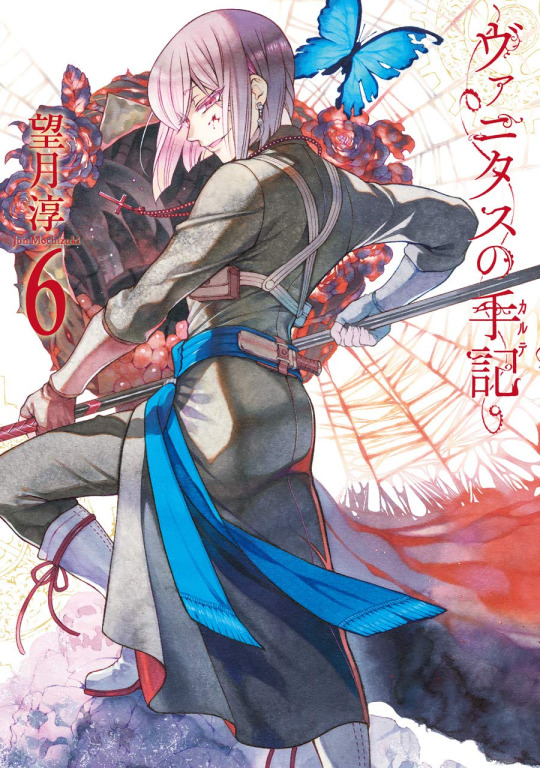
Really, all these covers are just so pretty. Here with Astolfo though, there's a couple of things that stand out. The spider's web, the butterfly, the damaged and odd mirror.
Let's start with the overall appeal. It's decrepit, it's damaged- tattered, if you will. A mess, a state of disrepair or lack of care. It all speaks to Astolfo's character, what his life left him as, and where he aims for. It's another more unspoken cover that digs deep into his character. For example, Have you realized that what they stand upon is a pile of skulls? Or that there is a fungus or something of the sort in place of the withered and dying roses along the bottom of the mirror? Or that the mirror itself is thorny?
Volume 7
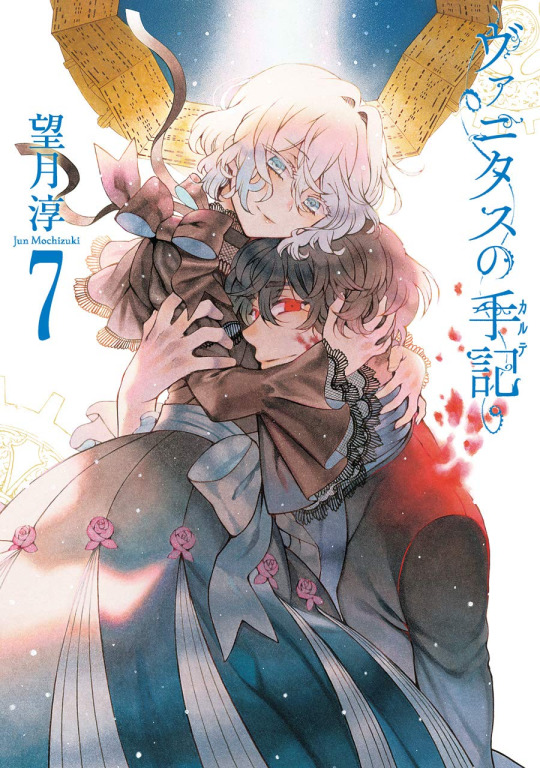
I do quite enjoy this one for how simple it is. Jeanne Jaques and Chloe share a mirror in this volume cover to better represent their relationship. And along the outline of the mirror is a type of music sheet to better relate to Chloe's history and purpose. To cap it all off is the positioning of the mirror though. Shining a light down from above, like they're trapped in a dark cage and it is the only source around them.
It's just really well done, and then there's the details on Jeanne Jacques, that he's the only one with blood on him, that his eyes are glowing and that he has that flame alight his left shoulder. It's really expert work and stuff you might not typically pick up on.
Volume 8

I could speak on this mirror for ages, but I will endeavor to keep it short. The mirror isn't just Domi's reflection, it is Domi. She's losing her sense of self, she's losing who she is, being pulled deeper into the cracked and dark mirror. Falling deeper into the visage of her brother Louis who has turned his back on her. She has her sword drawn, a sense of duty mixed with fear and sorrow is traced across her face. She's afraid that the boundaries that comprise Domi are being broken apart, not much unlike the mirror, and that she'll lose sight of herself as guilt drags her deeper into memory.
Vol 9

Butterflies are something that we manage to see quite a bit of in these covers thanks to their symbolism. But more interesting than that is the standout butterfly, the one butterfly for noe that shines red against the hues of blue that Vanitas finds himself slumbering beneath, trapped within the desires of Mikhail.
It's a rather self-explanatory cover, but still a very solid one. The exterior of the mirror meant to mimic the Book of Vanitas, with pins decorating its exterior to "hold" it in place similar to how you pin an insect up to display it. Along with that is another show of the symbolism of chains, though this one in a different manner. It does not attach Vanitas to Mikahil, but rather Mikhail uses it to trap Vanitas.
Volume 10

And we finish the foray into the covers with volume 10. This one is very pretty, and the only cover in which we don't directly see Vanitas' earring. Of course, the mirror is his earring, as well as a window into both Vanitas and Noe.
More than that though, the mirrors themselves continue the theme of chains, as they decorate the exterior of the hourglass figure. Vanitas being responsible for the dark and rainy mirror of the top, with Noe taking the brighter bottom half. It's an interesting one to see given the covers for volume 3 and 5, but one that fits incredibly well with where the story leaves off at. Showing the opposite natures that the two posses, but that regardless, one will always fall into the other.
So there you have it, my takes on the importance and symbolism of Mochizuki Jun's expertly crafted manga covers. There's really such a great deal to appreciate in them, especially given how light the designs can be for them. They clearly went to great lengths to attach a theme to the covers that would be integral to the overall approach they have with the characters, and for that I'm really thankful (and impressed).
#the case study of vanitas#vanitas of the blue moon#noe archiviste#vanitas no carte#dominique de sade#vanitas jeanne#astolfo granatum#chloe d'apchier#les memoires de vanitas#anime and manga#manga#manga review
236 notes
·
View notes